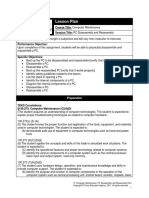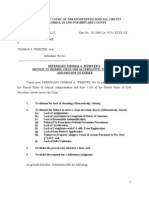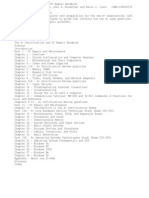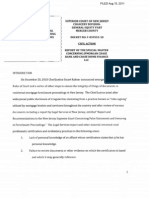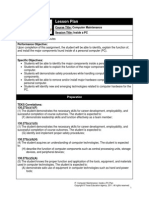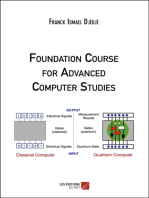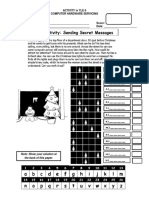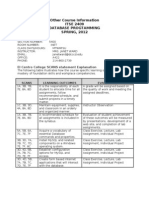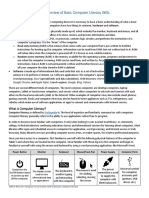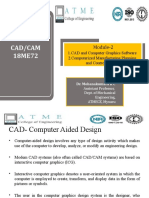02 10-Motherboards PDF
02 10-Motherboards PDF
Uploaded by
Camille Joy VeniegasCopyright:
Available Formats
02 10-Motherboards PDF
02 10-Motherboards PDF
Uploaded by
Camille Joy VeniegasOriginal Title
Copyright
Available Formats
Share this document
Did you find this document useful?
Is this content inappropriate?
Copyright:
Available Formats
02 10-Motherboards PDF
02 10-Motherboards PDF
Uploaded by
Camille Joy VeniegasCopyright:
Available Formats
Lesson Plan
Course Title: Computer Maintenance
Session Title: Motherboards
Lesson Duration: 180 minutes
Performance Objective:
Upon completion of this assignment, the student will understand the importance of the
motherboard, how it functions, and the many types of motherboards in the market today.
Specific Objectives:
• Describe the function of the motherboard.
• Identify the different types of motherboards and their functions.
• Identify the main components of the motherboard
• Determine the capabilities and limitations of the system.
• Identify the considerations when purchasing a motherboard.
• Recognize Expansion Card Architecture
• Recognize the relationship between CPU and Bus speeds and how to control them.
• Recognize the hardware configuration using DIP switches, jumpers, and CMOS.
• Identify the components of a typical board system layout.
• Identify the characteristics of various other motherboard layout types.
• Describe troubleshooting techniques and maintenance tips.
• Remove and install a motherboard in a PC.
• Sketch and label the components of a motherboard in a PC.
Preparation
TEKS Correlations:
This lesson, as published, correlates to the following TEKS. Any changes/alterations to the
activities may result in the elimination of any or all of the TEKS listed.
130.273(c)(1)
The student demonstrates the necessary skills for career development, employability, and
successful completion of course outcomes. The student is expected to:
(A) identify and demonstrate positive work behaviors that enhance employability and job
advancement such as regular attendance, promptness, attention to proper attire, maintenance
of a clean and safe work environment, appropriate voice, and pride in work;
(B) identify and demonstrate positive personal qualities such as flexibility, open-mindedness,
initiative, listening attentively to speakers, and willingness to learn new knowledge and skills;
(C) employ effective reading and writing skills;
(G) identify and implement proper safety procedures;
130.273(c)(3)
The student applies academic skills to the requirements of computer technologies. The student
is expected to:
(D) interpret appropriate documentation such as schematics, drawings, charts, diagrams,
IT: Computer Maintenance: Motherboards Plan
Copyright © Texas Education Agency, 2011. All rights reserved.1
technical manuals, and bulletins.
130.273(c)(4)
The student acquires an understanding of computer technologies. The student is expected to:
(A) explain the fundamentals of microprocessor theory;
(D) explain proper troubleshooting techniques as related to computer hardware;
(F) explain the relationships relative to data-communications theory;
(G) describe the architecture of various computer systems;
(H) describe the function of computer components such as central processing units, storage
devices, and peripheral devices; and
(I) explain computer system environmental requirements and related control devices.
130.273(c)(5)
The student knows the proper function and application of the tools, equipment, and materials
used in computer technologies. The student is expected to:
(A) demonstrate safe use of equipment in computer technologies such as hand and power
tools;
(B) employ available reference documentation such as tools, materials, and Internet sources to
access information as needed;
130.273(c)(6)
The student applies the concepts and skills of the trade in simulated work situations. The
student is expected to:
(C) identify the operational features and proper terminology related to computer systems;
(D) identify the various components of a computer system such as the central processor, basic
input and output system, read-only memory, and random access memory; and
130.273(c)(7)
The student uses hardware design, operation, and maintenance knowledge and skills to provide
computer support. The student is expected to:
(A) identify the purpose and function of computer components in the operation of the computer
system such as central processing unit, mother board, sockets, chipsets, basic input and output
system and their drivers, memory, hard drive technologies, video cards, input and output
devices and ports, and modem and network interface cards (NIC);
(D) assemble and install a basic computer system; and
(E) install and configure computer components and peripherals.
125.46(c)(8)
The student uses troubleshooting skills with hardware knowledge to solve client problems. The
student is expected to:
(A) understand the rationale behind error messages and symptoms of hardware failures;
(D) test system using diagnostic tools and software;
(J) repair malfunctioning hardware systems;
Instructor/Trainer
References:
Peter Norton’s Introduction to Computers 4th Edition, Lesson 2: Standard Methods of Input
PC Upgrade and Repair Simplified 2nd Edition
Comp TIA’s A+ Certification Handbook
www.Intel.com
IT: Computer Maintenance: Motherboards Plan
Copyright © Texas Education Agency, 2011. All rights reserved.2
Instructional Aids:
1. Motherboard PowerPoint Presentation
2. Motherboard PowerPoint Presentation – Handouts
3. Motherboard Organizer
4. Motherboard Exam
5. Motherboard Exam Key
6. Motherboard – Lab
7. Motherboard – Lab Scoring Rubric
Materials Needed:
1. Copies of the Organizer (1 per student)
2. Copies of the Lab Assignment (1 per student)
Equipment Needed:
1. A projection system to play the PowerPoint presentation
2. Computers that the student can take apart and work with
Learner
Students should read the appropriate curriculum material on motherboards, depending on the
text/ curriculum being used for this course. This lesson can be taught with only the PowerPoint
presentation, and the equipment outlined above.
Introduction
MI Introduction (LSI Quadrant I):
SAY: The motherboard houses the CPU and allows all other devices to
communicate within the PC.
SAY: The motherboard is also called the system board and is the most complex
component in the computer.
ASK: Has anyone ever seen the motherboard inside the computer? It is the single
largest printed circuit board inside the computer and is either green or gold.
SAY: There are several factors that should be considered when selecting a
motherboard, such as the form factor, power management, processor socket,
chipsets, memory, buses, and BIOS. We will go over these factors in further
detail.
Outline
MI Outline (LSI Quadrant II): Instructor Notes:
Lesson Introduction and Overview (PPT Slides 1-4) Note: Instructors can use
I. Describe the function of the motherboard the PowerPoint slides,
(PPT Slide 5). handouts, and note pages in
II. Identify the different types of motherboards conjunction with the following
and their characteristics (PPT Slide 6). outline.
III. Identify the main components of the
motherboard (PPT Slide 7).
IT: Computer Maintenance: Motherboards Plan
Copyright © Texas Education Agency, 2011. All rights reserved.3
Note: The teacher should
IV. Determine the capabilities and limitations of handout 1 Motherboards
the motherboard system (PPT Slide 8). Organizer per student.
V. Identify considerations when purchasing a Display the PowerPoint
motherboard (PPT Slide 9). presentation, Motherboards,
1. Information provided on the system using a computer and
clock and chipset (PPT Slides 10-14). projector. Students will fill in
2. Information provided on the bus the organizer during the
systems and expansion slots (PPT presentation.
Slides 15-17).
VI. Recognize Expansion Card Architecture
(PPT Slides 19-23).
VII. Recognize the relationship between the
CPU and Bus speeds and how to control
them (PPT Slides 24-26).
VIII. Recognize hardware configuration using
DIP switches, jumpers, and CMOS (PPT
Slides 27-29).
IX. Identify the components of the typical board
system layout (PPT Slide 30).
X. Identify the characteristics of other types of
motherboard layouts (PPT Slides 31-36).
XI. Describe troubleshooting techniques and
maintenance tips (PPT Slides 37-38).
XII. The students remove and install a The teacher should hand out
motherboard on a PC (refer to the lab the Lab Assignment 1 sheet
assignment sheet for the steps). to the students and review
the instructions.
XIII. Sketch and label the components of a
motherboard in a PC (refer to the lab Using a PC, the teacher
assignment sheet for the steps). should now demonstrate how
to properly remove and install
a motherboard by following
the steps listed on the lab
assignment sheet. Allow the
students to make notes that
will help them during the lab
activity on the lab sheets.
Application
MI Guided Practice (LSI Quadrant III):
1. The teacher demonstrates each lab principle.
2. The teacher maintains direct supervision in the lab, providing guidance when
warranted.
IT: Computer Maintenance: Motherboards Plan
Copyright © Texas Education Agency, 2011. All rights reserved.
MI Independent Practice (LSI Quadrant III):
1. Students work individually on lab assignments, demonstrating their skills in
identifying and discussing the various lab requirements and results.
Summary
MI Review (LSI Quadrants I and IV):
Checking for understanding (Q&A Session)
Q: What is the main function of the motherboard?
A: The motherboard houses the CPU and allows all other devices to
communicate within the PC.
Q: What is another name for the motherboard?
A: System board.
Q: Name the four types of motherboards?
A: ATX, Baby ATX, AT, and mini AT.
Q: What are some of the components found on the motherboard?
A: CPU, system clock, buses, expansion slots, BIOS, memory, CMOS.
Q: What are some of the things you should look for when choosing a
motherboard?
A: Form factor, Power management, processor socket, chipset, memory,
buses, and BIOS.
Evaluation
MI Informal Assessment (LSI Quadrant III):
Monitor student progress during independent practice and provide independent re-
teach/redirection as needed.
MI Formal Assessment (LSI Quadrant III, IV):
Use the Lab Assignment Scoring Rubric
Use the Motherboard Exam and Exam Key.
Extension
MI Extension/Enrichment (LSI Quadrant IV):
▪ Students that have mastered the lab assignments can peer-tutor students (one-
on-one) that are having difficulty performing the lab.
▪ Students demonstrating mastery of the lab assignments may also be called
upon to apply learning by assisting the Campus Technologist in maintaining,
repairing, or upgrading campus equipment.
IT: Computer Maintenance: Motherboards Plan
Copyright © Texas Education Agency, 2011. All rights reserved.
Personal Development
Icon MI Teaching Strategies
Strategies
Lecture, discussion, journal Reading, highlighting, outlining,
Verbal/ writing, cooperative learning, teaching others, reciting information
Linguistic word origins
Problem-solving, number Organizing material logically, explaining
Logical/ games, critical thinking, things sequentially, finding patterns,
Mathematical classifying and organizing, developing systems, outlining, charting,
Socratic questioning graphing, analyzing information
Mind-mapping, reflective Developing graphic organizers, mind-
time, graphic organizers, mapping, charting, graphing, organizing
Visual/Spatial color-coding systems, with color, mental imagery (drawing in
drawings, designs, video, the mind’s eye)
DVD, charts, maps
Use music, compose songs Creating rhythms out of words, creating
Musical/ or raps, use musical rhythms with instruments, playing an
Rhythmic language or metaphors instrument, putting words to existing
songs
Use manipulatives, hand Moving while learning, pacing while
signals, pantomime, real life reciting, acting out scripts of material,
Bodily/
situations, puzzles and board designing games, moving fingers under
Kinesthetic games, activities, role- words while reading
playing, action problems
Reflective teaching, Reflecting on personal meaning of
interviews, reflective listening, information, studying in quiet settings,
Intrapersonal KWL charts imagining experiments, visualizing
information, journaling
Cooperative learning, role- Studying in a group, discussing
Interpersonal playing, group brainstorming, information, using flash cards with
cross-cultural interactions others, teaching others
Natural objects as Connecting with nature, forming study
Naturalist manipulatives and as a groups with like-minded people
background for learning
Socratic questions, real life Considering the personal relationship to
situations, global the larger context
Existentialist
problems/questions
IT: Computer Maintenance: Motherboards Plan
Copyright © Texas Education Agency, 2011. All rights reserved.
Motherboards PowerPoint Outline
Objectives
• Describe the function of the motherboard.
• Identify the different types of motherboards and their functions.
• Identify the main components of the motherboard.
• Determine the capabilities and limitations of the system.
• List the considerations when purchasing a motherboard.
• Identify the typical board system layout and variations in layout of other
motherboard types.
• Identify motherboard troubleshooting techniques and maintenance tips.
I. Function of a Motherboard
A. Houses the ______________
B. Allows all devices to ______________ with the motherboard and with
____________________ _________________________
C. Determines the ______________ and _________________ of the system
II. 4 Types of Motherboards
Type of Description
Motherboard
• Oldest type of motherboard
• UsesP8 and P9 ________________
• Measures ______ inches X ______ inches
• Smaller version of above
• UsesP8 and P9 ________________
• Measures ______ inches X ______ inches
• Developed by Intel for _________ systems, and more
convenient than above
• Includes a power-on switch that can be
________________
• Uses a _____ connector
• Measures ______ inches X ______ inches
• More compact than above
• Measures ______ inches X ______ inches
IT: Computer Maintenance: Motherboards Plan
Copyright © Texas Education Agency, 2011. All rights reserved.
III. Main Components on a Motherboard
1. 2. 3. 4. 5.
6. 7. 8. 9. 10.
IV. Selection of a Motherboard Determines
A. CPU ________ and speeds
B. Chip ____ on the board
C. Memory cache ______ and ________
D. Types and number of ______________ _________
E. Type of ___________. Examples: ______, _______, ________,
_________, or _________
F. Type of _______________. What ____________ and how ____________
________________________ and ______________________
G. Type of ______
H. ROM ______
I. Type of ________ connector
J. Presence/absence of proprietary _______, local _____ _______, _______
adapters and _______ controller, ______ports, LPT ______, and ______
port
V. Considerations when Selecting a system board
A. Circle only the letters A-J in section IV above that you need to consider
when choosing a motherboard.
IT: Computer Maintenance: Motherboards Plan
Copyright © Texas Education Agency, 2011. All rights reserved.
VI. The System Clock
A. Keeps the ______ for motherboard activities
B. Frequency is measured in _________
C. Wait state occurs when
_________________________________________________.
VII. The Chip Set
A. Set of chips on the motherboard that collectively ________ the memory
________, external __________, and some ______________________
VIII. Buses Types
Bus Type Description
This is a ____-directional pathway, which means that
information can flow ______ ______.
This is a ____-directional pathway, which means that
information can flow ______ ________________.
This carries the __________ and __________ signals
needed to coordinate the activities of the entire computer.
IX. Buses and Expansion Slots
A. Today’s PCs have _____ or ____ buses.
B. A bus carries ___________ __________, ___________ signals,
____________ addresses, and data.
C. On-board ports.
IT: Computer Maintenance: Motherboards Plan
Copyright © Texas Education Agency, 2011. All rights reserved.
X. Relationship of CPU Speed to Bus Speed
A. When the multiplier is large, overall performance of system is ________
than when it is small.
B. Change the speed of a computer by changing __________ of the system
______, or by changing ______________ that determines ________ of
______________________.
XI. CPU and Bus Speeds
A. CPU speed is determined by _________________________ X
____________.
1. Typical speeds are ___________, _____________ and
_____________.
2. Controlled by ___________, ____________, ____________
B. Memory or system bus speed is based on ___________________
1. Typical values are ____________ to ______________
2. Controlled by: ____________, ______________, ___________
C. PCI bus speed: ____________ by 2
1. Setting the speed of ________________________ sets the speed
of the PCI bus.
D. ISA bus: runs as ______________ speed: ___________.
XII. Hardware configuration
A. Tells the CPU what hardware ________________ are present and how
they are ______________ to interface with the CPU.
B. Provided on the motherboard by ________________,
_________________, and _____________
IT: Computer Maintenance: Motherboards Plan
Copyright © Texas Education Agency, 2011. All rights reserved.
XIII. A Typical System Board Layout:
1. 2. 3.
4. 5. 6.
XIV. How does the Dual Processor Motherboard differ from the typical layout?
_____________________________________________________________
XV. On the typical system board layout above, mark the ISA slot and the battery.
XVI. Troubleshooting and Maintenance
A. If the motherboard is not working properly, the problem is often caused by:
___________________________________________________________.
B. What should you do first in the troubleshooting process?
____________________________________________________________
___________________________________________________________.
IT: Computer Maintenance: Motherboards Plan
Copyright © Texas Education Agency, 2011. All rights reserved.
C. If this doesn’t work, what should you do next?
___________________________________________________________.
D. What should you do if no components are found to be faulty?
_____________________ ________________ or a _________________
____________________.
E. What type of software can be purchased to test the motherboard?
__________________________________
F. Always check the ____________________ that is included with your
motherboard to determine the proper __________________.
G. To prevent the computer from overheating check the _____ for proper
function.
H. Many motherboards have built-in ______________________ that will shut
down the computer before it overheats.
I. To clean your motherboard, you can use a can of __________________
____________ to blow away the dust.
Additional Notes:
IT: Computer Maintenance: Motherboards Plan
Copyright © Texas Education Agency, 2011. All rights reserved.
Student Name:
Computer Maintenance - Motherboards Lab
Part 1 – Replacing a Motherboard
Step 1
Before replacing a motherboard, turn off the computer and unplug the power cable.
Remove the cover from the computer case and ground yourself.
Step 2
Disconnect the cables from the back of the computer and remove the expansion cards from
the expansion slots.
Step 3
Disconnect all cables from the motherboard.
Step 4
Remove the screws that are holding the motherboard to the computer case.
Step 5
Slide the motherboard a bit sideways to release the small plastic spacers, and lift the board
out of the computer case.
Step 6
If necessary, add the plastic spacers from the old motherboard to the new motherboard.
Step 7
Place the new motherboard into the computer case, slide the board into position, and
secure it with the screws. Reconnect all the cables, re-install the expansion cards, and
place the cover on the computer case.
Part 2 – Identifying the Components on a Motherboard
Step 1
Look carefully at the motherboard you removed from the PC.
Step 2
Sketch the layout of the major components of the motherboard onto the grid sheet
provided.
Step 3
Label the major components listed as 1-9 on your sketch.
Step 4
Identify the type of motherboard in your layout sketch: ____________________
Step 5
Justify your answer to step 4 above: _________________________________________
______________________________________________________________________
______________________________________________________________________
IT: Computer Maintenance: Motherboards Plan
Copyright © Texas Education Agency, 2011. All rights reserved.
1. Power Supply connections 6. System bus with expansion slots
2. System clock 7. CMOS chip and battery
3. CPU / chip set 8. Ram
4. Jumpers and DIP switches 9. Ports mounted on the board/ list type
5. ROM BIOS
IT: Computer Maintenance: Motherboards Plan
Copyright © Texas Education Agency, 2011. All rights reserved.
Computer Maintenance
Name _________________________________ Date ______________________________
Motherboards Exam
Multiple Choice
1. The motherboard does all of the following EXCEPT
a. Houses the CPU
b. Allow all devices to communicate with each other
c. Determine capabilities and limitation of the system
d. Converts AC power to DC power
2. What are the four different types of motherboards?
a. AT, Baby AT, ATX, and Mini ATX
b. AT, ATM, ATX and Mini ATX
c. ATV, ATX, AT, and Baby AT
d. None of the above
3. All of the following are main components of the motherboard EXCEPT
a. CPU
b. System Clock
c. Hard drive
d. RAM
4. When choosing a motherboard, the following should be considered
a. Form Factor
b. Memory
c. Processor Socket
d. All of the above
5. The following are Bus types in a computer EXCEPT
a. Address bus
b. Data bus
c. Control bus
d. Tether bus
True/False
6. _____ When a motherboard is not working properly, a malfunctioning component may
be causing the problem.
7. _____ Diagnostic software allows you to test your motherboard.
8. _____ Checking the documentation included with your motherboard could determine
how much space is available in your hard drive.
IT: Computer Maintenance: Motherboards Plan
Copyright © Texas Education Agency, 2011. All rights reserved.
9. _____ To prevent your computer from overheating, remove the cover while using the
computer.
10. _____ A can of compressed air can be used to blow away the dust and dirt on the
mother board.
Short Answer
11. Briefly describe the function of the motherboard.
12. List at least 5 components found on the motherboard.
13. What can be done if the motherboard is not working properly? Explain.
14. How can you prevent your computer from overheating?
15. List at least five things that should be considered when choosing a motherboard.
IT: Computer Maintenance: Motherboards Plan
Copyright © Texas Education Agency, 2011. All rights reserved.
Computer Maintenance
Motherboards Exam - KEY
Multiple Choice
1. The motherboard does all of the following EXCEPT
a. Houses the CPU
b. Allow all devices to communicate with each other
c. Determine capabilities and limitation of the system
d. Converts AC power to DC power
2. What are the four different types of motherboards?
a. AT, Baby AT, ATX, and Mini ATX
b. AT, ATM, ATX and Mini ATX
c. ATV, ATX, AT, and Baby AT
d. None of the above
3. All of the following are main components of the motherboard EXCEPT
a. CPU
b. System Clock
c. Hard drive
d. RAM
4. When choosing a motherboard, the following should be considered
a. Form Factor
b. Memory
c. Processor Socket
d. All of the above
5. The following are Bus types in a computer EXCEPT
a. Address bus
b. Data bus
c. Control bus
d. Tether bus
True/False
6. _____ When a motherboard is not working properly, a malfunctioning component may
be causing the problem. T
7. _____ Diagnostic software allows you to test your motherboard. T
8. _____ Checking the documentation included with your motherboard could determine
how much space is available in your hard drive. F
9. _____ To prevent your computer from overheating, remove the cover while using the
computer. F
10. _____ A can of compressed air can be used to blow away the dust and dirt on the
mother board. T
IT: Computer Maintenance: Motherboards Plan
Copyright © Texas Education Agency, 2011. All rights reserved.
Short Answer
11. Briefly describe the function of the motherboard.
Houses the CPU
Allow all devices to communicate with the motherboard and with each other
Determine capabilities and limitations of the system
12. List at least 5 components found on the motherboard.
System clock
CPU and its chip set
System bus with expansion slots
Jumpers and DIP switches
ROM BIOS
CMOS configuration chip and its battery
RAM
RAM cache (L2) (optional)
Ports directly on the board
Power supply connections
13. What can be done if the motherboard is not working properly? Explain
If the motherboard is not working properly, the problem is often caused by a component
that is not functioning properly.
One should remove a component not required for basic operation and then start the
computer to see if the problem is still exists. Repeat this with different components until
you find the one that is causing the error.
If no components are found to be faulty, the computer may have a loss of power or a
computer virus.
Diagnostic software may be purchased at most computer stores to test your
motherboard.
Always check the documentation that is included with your system board to determine
proper settings.
14. How can you prevent your computer from overheating?
To prevent the computer from overheating, verify that the fan is working properly. Many
motherboards have built-in thermometers that will shut down the computer before it
overheats
15. List at least five things that should be considered when choosing a motherboard.
Type of case
ROM BIOS
Type of keyboard connector
Presence/absence of proprietary video and/or proprietary local bus slots
Presence/absence of IDE adapters and SCSI controller
Presence/absence of COM ports, LPT ports, and mouse port
Form factor
Power factor
Processor
IT: Computer Maintenance: Motherboards Plan
Copyright © Texas Education Agency, 2011. All rights reserved.
Motherboards Lab Assignment Scoring Rubric
Total possible points: 80
9-10 Points 6-8 Points 4-5 Points 0-3 Points Awarded
TECHNICAL
LAB REPORT
SKETCH: DRAW
ALL 4-5 2-3 0-1
the LOCATION
COMPONENTS COMPONENTS COMPONENTS COMPONENTS
OF the
components
LAB REPORT
ALL 4-5 2-3 0-1
SKETCH: Identify
COMPONENTS COMPONENTS COMPONENTS COMPONENTS
THE components
DISCONNECTED
ALL 4-5 2-3 0-1
ALL
COMPONENTS COMPONENTS COMPONENTS COMPONENTS
COMPONENTS
REMOVED
REMOVED REMOVED
REMOVED WITH DID NOT
WITHOUT WITH VERBAL
MOTHERBOARD PHYSICAL REMOVE
ASSISTANCE ASSISTANCE
ASSISTANCE
REPLACED
REPLACED REPLACED
REPLACED WITH DID NOT
WITHOUT WITH VERBAL
MOTHERBOARD PHYSICAL REPLACE
ASSISTANCE ASSISTANCE
ASSISTANCE
RETURNED ALL
COMPONENTS
ALL 4-5 2-3 0-1
TO THE PC IN
COMPONENTS COMPONENTS COMPONENTS COMPONENTS
PROPER
LOCATION
WORK AREA
SUPERIOR SUITABLE MEDIOCRE INADEQUATE
CLEAN
FOLLOWED
SAFETY SUPERIOR SUITABLE MEDIOCRE INADEQUATE
GUIDELINES
Total points
awarded
IT: Computer Maintenance: Motherboards Plan
Copyright © Texas Education Agency, 2011. All rights reserved.
You might also like
- Online ShoppingDocument31 pagesOnline ShoppingAmit Kaushik0% (1)
- Record Management System For Department of Social Welfare and Development PDFDocument111 pagesRecord Management System For Department of Social Welfare and Development PDFBob Bob75% (4)
- Amended Motion To Dismiss DK T 18Document5 pagesAmended Motion To Dismiss DK T 18Michael PaulNo ratings yet
- Local Rules For The 13th Circuit of Hillsborough CountyDocument32 pagesLocal Rules For The 13th Circuit of Hillsborough Countyidris2111No ratings yet
- Hold HarmlessDocument2 pagesHold HarmlessmobileiskevNo ratings yet
- 04.01 PC Dis Re AssemblyDocument29 pages04.01 PC Dis Re Assemblyjanet lofrancoNo ratings yet
- ServiceManual For Data Communication EUDocument3 pagesServiceManual For Data Communication EUAshan JayawardenaNo ratings yet
- Automatic Rule-Based Checking of Building DesignsDocument23 pagesAutomatic Rule-Based Checking of Building DesignsRicardo Moço100% (1)
- Micro Project Report On MotherboardDocument15 pagesMicro Project Report On Motherboardabu100% (14)
- 3 3 3 Reverse Engineering Worksheet-JoDocument6 pages3 3 3 Reverse Engineering Worksheet-Joapi-291536771100% (1)
- sss-foreclosed-properties-HAA For Sale As of July 31 2020 PDFDocument18 pagessss-foreclosed-properties-HAA For Sale As of July 31 2020 PDFFrances PaulineNo ratings yet
- Webster MTDDocument18 pagesWebster MTDStopGovt WasteNo ratings yet
- Appellants Opening Brief FINAL With ALL 9-8-14Document57 pagesAppellants Opening Brief FINAL With ALL 9-8-14Nancy Duffy McCarronNo ratings yet
- Notesheet PhysicsDocument3 pagesNotesheet PhysicsstmakidNo ratings yet
- Prudenciano DecisionDocument10 pagesPrudenciano DecisionAsbury Park PressNo ratings yet
- Grammar Chapter 1Document14 pagesGrammar Chapter 1Carlos CabreraNo ratings yet
- Anti-Unpacker Part2Document6 pagesAnti-Unpacker Part2elabirNo ratings yet
- God Consciousness ExperienceDocument1 pageGod Consciousness ExperiencePal SahotaNo ratings yet
- The AwakeningDocument2 pagesThe AwakeningPal Sahota100% (1)
- Gov Uscourts Canb 522575 288 0Document9 pagesGov Uscourts Canb 522575 288 0Ars TechnicaNo ratings yet
- 60 GHZ Beamforming Transmitter Design For Pulse Doppler RadarDocument135 pages60 GHZ Beamforming Transmitter Design For Pulse Doppler Radarcowboy1980No ratings yet
- Appeal Motion To Quash Service State Illinois 1133555 - R23Document7 pagesAppeal Motion To Quash Service State Illinois 1133555 - R23sbhasin1100% (1)
- County Silver Bluff AppealDocument37 pagesCounty Silver Bluff Appealal_crespoNo ratings yet
- Spotify Memorandum in Support of Motion For More Definite StatementDocument11 pagesSpotify Memorandum in Support of Motion For More Definite StatementDigital Music News100% (1)
- Hotfile's Motion in Limine To Preclude Use of Pejorative Terms PDFDocument4 pagesHotfile's Motion in Limine To Preclude Use of Pejorative Terms PDFDevlin HartlineNo ratings yet
- CO Motion For Denial CompleteDocument224 pagesCO Motion For Denial CompleteDaniel Deydanyu Nesta JohnsonNo ratings yet
- The A+ Certification and PC Repair Handbook EbookDocument1 pageThe A+ Certification and PC Repair Handbook EbookBeljon LimNo ratings yet
- The Legal Relationship Between The Bank and Its Safe Deposit Cust PDFDocument42 pagesThe Legal Relationship Between The Bank and Its Safe Deposit Cust PDFDexterQ.TuallaNo ratings yet
- Appendix: Evidence Base For Homes, Not Jails (April 2015)Document55 pagesAppendix: Evidence Base For Homes, Not Jails (April 2015)SQUASH13No ratings yet
- To Make Comparative Study On MotherboardsDocument13 pagesTo Make Comparative Study On MotherboardsPankaj GillNo ratings yet
- Gov. Evers Wisc MotionDocument31 pagesGov. Evers Wisc MotionLaw&CrimeNo ratings yet
- ComplaintDocument37 pagesComplaintJonathan FrutkinNo ratings yet
- Emilee Carpenter Notice of AppealDocument18 pagesEmilee Carpenter Notice of AppealGrant GebetsbergerNo ratings yet
- USPS Employee Mauro Pennini Under AttackDocument3 pagesUSPS Employee Mauro Pennini Under AttackAllen Carlton Jr.No ratings yet
- Evictions, and The Rights-Based Approach To Urban DevelopmentDocument176 pagesEvictions, and The Rights-Based Approach To Urban DevelopmentUnited Nations Human Settlements Programme (UN-HABITAT)No ratings yet
- Kleiman v. Wright - Subpoenas To Jimmy NguyenDocument15 pagesKleiman v. Wright - Subpoenas To Jimmy NguyenVel FreedmanNo ratings yet
- On The Creation of Automatic Identification and Data Capture Infrastructure Via RFIDDocument19 pagesOn The Creation of Automatic Identification and Data Capture Infrastructure Via RFIDhamzeecoNo ratings yet
- Super and Anonymised InjunctionsDocument12 pagesSuper and Anonymised InjunctionsPhilip Reynor Jr.No ratings yet
- USDC EDV A Opposition To Report For SanctionsDocument15 pagesUSDC EDV A Opposition To Report For SanctionsJames Renwick Manship, Sr.100% (1)
- Zarro Inference 1 Report of The Special Master Concerning Jpmorgan Chase Bank and Chase Home Finance - Aug 15, 2011Document30 pagesZarro Inference 1 Report of The Special Master Concerning Jpmorgan Chase Bank and Chase Home Finance - Aug 15, 2011DeontosNo ratings yet
- Instt Liist QQDocument400 pagesInstt Liist QQjnmanivannanmechNo ratings yet
- Final Brief - FinalDocument67 pagesFinal Brief - FinalNick SarconeNo ratings yet
- Document 414 Memorandum of Law in Support of Governments Motion To Admit Certain Rackleteering Evidence 03.12.2019Document43 pagesDocument 414 Memorandum of Law in Support of Governments Motion To Admit Certain Rackleteering Evidence 03.12.2019Zerohedge Janitor100% (2)
- Manual Apple 1 ROMcarddDocument10 pagesManual Apple 1 ROMcarddAnonymous qTKCWlxNo ratings yet
- Motion To Dismiss 14CR437Document38 pagesMotion To Dismiss 14CR437Emily CohenNo ratings yet
- Home Expressions v. Keter Luxembourg - Complaint (Trade Dress DJ)Document20 pagesHome Expressions v. Keter Luxembourg - Complaint (Trade Dress DJ)Sarah BursteinNo ratings yet
- Amicus Brief of Matrimonial LawyersDocument46 pagesAmicus Brief of Matrimonial LawyersEquality Case FilesNo ratings yet
- EFF - DocuColor Tracking Dot Decoding GuideDocument6 pagesEFF - DocuColor Tracking Dot Decoding GuideTim BryantNo ratings yet
- Equitable PCI Bank V OngDocument25 pagesEquitable PCI Bank V OngHeidiNo ratings yet
- Lewin Request ExaminationDocument6 pagesLewin Request ExaminationYTOLeaderNo ratings yet
- Appellants Reply BriefDocument17 pagesAppellants Reply BriefhefflingerNo ratings yet
- AttachmentDocument49 pagesAttachmentAlhaji Mamah Sesay0% (1)
- Justiça Dos EUA: Gol e LatamDocument128 pagesJustiça Dos EUA: Gol e LatamVitória PitangaNo ratings yet
- Inside PCDocument17 pagesInside PCapi-298810403No ratings yet
- Computer Studies Syllabus 1Document64 pagesComputer Studies Syllabus 1Nakhabala MauriceNo ratings yet
- KCSE Computer Studies SyllabusDocument65 pagesKCSE Computer Studies SyllabusFredie Chumvi TamuNo ratings yet
- CMTSDocument8 pagesCMTSvjmakwanaNo ratings yet
- It Workshop Lab Manual: Csi Wesley Institute of Tech &SCDocument82 pagesIt Workshop Lab Manual: Csi Wesley Institute of Tech &SCmr copy xeroxNo ratings yet
- It Workshop Lab Manual: Csi Wesley Institute of Tech &SCDocument82 pagesIt Workshop Lab Manual: Csi Wesley Institute of Tech &SCmr copy xeroxNo ratings yet
- PC Hardware Servicing Teacher's GuideDocument7 pagesPC Hardware Servicing Teacher's GuidedanballaisNo ratings yet
- 1st SEM IT RecordDocument97 pages1st SEM IT Recordhasnainaali247No ratings yet
- ICT Syllabus Form 1 - 4Document46 pagesICT Syllabus Form 1 - 4ALI MWALIMU0% (1)
- CA Sp06 m01 IntroDocument14 pagesCA Sp06 m01 IntroBereket GetachewNo ratings yet
- Notes For CAE-1 - All TopicsDocument60 pagesNotes For CAE-1 - All Topicsplantforest16No ratings yet
- Technology and Livelihood Education Access Delivery Mode For Grade 8 Fourth QuarterDocument2 pagesTechnology and Livelihood Education Access Delivery Mode For Grade 8 Fourth QuarterCamille Joy Veniegas100% (1)
- Western Bicutan National High School: Date Coverage of The Given Activity Title/Topic Remarks/Description of The ActivityDocument2 pagesWestern Bicutan National High School: Date Coverage of The Given Activity Title/Topic Remarks/Description of The ActivityCamille Joy VeniegasNo ratings yet
- Western Bicutan National High School: Date Coverage of The Given Activity Title/Topic Remarks/Description of The ActivityDocument2 pagesWestern Bicutan National High School: Date Coverage of The Given Activity Title/Topic Remarks/Description of The ActivityCamille Joy VeniegasNo ratings yet
- Western Bicutan National High School: Date Coverage of The Given Activity Title/Topic Remarks/Description of The ActivityDocument2 pagesWestern Bicutan National High School: Date Coverage of The Given Activity Title/Topic Remarks/Description of The ActivityCamille Joy VeniegasNo ratings yet
- Minutes of Meeting PTA - 3rdDocument1 pageMinutes of Meeting PTA - 3rdCamille Joy VeniegasNo ratings yet
- Tle Info Sheet1 2Document3 pagesTle Info Sheet1 2Camille Joy VeniegasNo ratings yet
- Summative Test in Tle8inputoutputDocument2 pagesSummative Test in Tle8inputoutputCamille Joy VeniegasNo ratings yet
- Binary Numbers Lesson PlanDocument1 pageBinary Numbers Lesson PlanCamille Joy VeniegasNo ratings yet
- Flowchart A Flowchart Is A Diagram That Uses Graphic Symbols To Depict The Nature and Flow of The Steps in A ProcessDocument14 pagesFlowchart A Flowchart Is A Diagram That Uses Graphic Symbols To Depict The Nature and Flow of The Steps in A ProcessCamille Joy VeniegasNo ratings yet
- Grade 10 (Computer System Servicing) : Western Bicutan National High School Ph1 Ep Housing Pinagsama Taguig CityDocument6 pagesGrade 10 (Computer System Servicing) : Western Bicutan National High School Ph1 Ep Housing Pinagsama Taguig CityCamille Joy VeniegasNo ratings yet
- Activity in Tle 8 Computer Hardware Servicing: The Back of This PaperDocument1 pageActivity in Tle 8 Computer Hardware Servicing: The Back of This PaperCamille Joy VeniegasNo ratings yet
- Binary The Term Bit Is An Abbreviation of Binary Digit and Represents The Smallest Piece of Data. A Bit Can HaveDocument10 pagesBinary The Term Bit Is An Abbreviation of Binary Digit and Represents The Smallest Piece of Data. A Bit Can HaveCamille Joy VeniegasNo ratings yet
- A That Can Read Text or Illustrations Printed On PaperDocument2 pagesA That Can Read Text or Illustrations Printed On PaperCamille Joy VeniegasNo ratings yet
- Desalination RevDocument1 pageDesalination RevCamille Joy VeniegasNo ratings yet
- Common Wire Splices And: JointsDocument12 pagesCommon Wire Splices And: JointsCamille Joy VeniegasNo ratings yet
- Grade 3: List of Sped/Suspected Sped Students and Their BehaviorDocument2 pagesGrade 3: List of Sped/Suspected Sped Students and Their BehaviorCamille Joy VeniegasNo ratings yet
- Proper Storage of Tools, Parts and EquipmentDocument4 pagesProper Storage of Tools, Parts and EquipmentCamille Joy VeniegasNo ratings yet
- Grade 10 (Computer System Servicing) : Western Bicutan National High School Ph1 Ep Housing Pinagsama Taguig CityDocument3 pagesGrade 10 (Computer System Servicing) : Western Bicutan National High School Ph1 Ep Housing Pinagsama Taguig CityCamille Joy VeniegasNo ratings yet
- Commonwiresplicesandjoints PDFDocument14 pagesCommonwiresplicesandjoints PDFCamille Joy VeniegasNo ratings yet
- FST 2004-03 682300g1Document300 pagesFST 2004-03 682300g1Horacio TerragnoNo ratings yet
- Chapter 4 SoftwareDocument15 pagesChapter 4 Softwarea2080903768No ratings yet
- Distributed Systems CSE 2052 Module 1 Dr. Jayakumar 26 Aug 2023Document60 pagesDistributed Systems CSE 2052 Module 1 Dr. Jayakumar 26 Aug 2023chinmayavaishnaviNo ratings yet
- Other Course Information ITSE 2409 Database Progtamming SPRING, 2012Document5 pagesOther Course Information ITSE 2409 Database Progtamming SPRING, 2012Janet Palmer Ward ΦθκNo ratings yet
- Computer ScienceDocument2 pagesComputer ScienceHell YeahNo ratings yet
- James A. Senn's Information Technology, 3 Edition: Essentials of ComputingDocument41 pagesJames A. Senn's Information Technology, 3 Edition: Essentials of ComputingAlizay malikNo ratings yet
- Devry University Course of StudyDocument3 pagesDevry University Course of Studyapi-291590435No ratings yet
- IT 101 Syllabus-ObeDocument11 pagesIT 101 Syllabus-ObeCrash Zerocool100% (3)
- Cyclic Symmetry TopicsDocument73 pagesCyclic Symmetry TopicsMoisés MachadoNo ratings yet
- Computer Education & PublicationDocument25 pagesComputer Education & PublicationMICA EDUCATIONALNo ratings yet
- Avionic Computer FV-4000Document2 pagesAvionic Computer FV-4000Thomas KrauseNo ratings yet
- Project Oxygen VijethDocument22 pagesProject Oxygen Vijethವಿಜೇತ್ಹೆಗಡೆNo ratings yet
- An Overview of Basic Computer Literacy SkillsDocument5 pagesAn Overview of Basic Computer Literacy SkillsV3RD 4OLSNo ratings yet
- Stanford Computer Science Curriculum Revision-Preview-04-03-08Document9 pagesStanford Computer Science Curriculum Revision-Preview-04-03-08MichaelNo ratings yet
- Performance: Computer Architecture and Assembly Language Dr. Aiman El-MalehDocument25 pagesPerformance: Computer Architecture and Assembly Language Dr. Aiman El-MalehJawwad RafiqNo ratings yet
- Personalized Expense Managing Assistant Using Android: AbstractDocument8 pagesPersonalized Expense Managing Assistant Using Android: AbstractJey Quintana RadaNo ratings yet
- Ics F2 2023Document11 pagesIcs F2 2023danielbuberwa1No ratings yet
- Part One - 40 Part Two - 60Document5 pagesPart One - 40 Part Two - 60fmsrypNo ratings yet
- Foreign and Local InventorsDocument3 pagesForeign and Local InventorsJewel RiegoNo ratings yet
- CIM Module 2Document64 pagesCIM Module 2Mohanakumara K CNo ratings yet
- Computer Chapter 2 Worksheets No. 2 Class IXDocument23 pagesComputer Chapter 2 Worksheets No. 2 Class IXVihuto SwuNo ratings yet
- ST Xaviers College Prospectus 2019 20Document90 pagesST Xaviers College Prospectus 2019 20Sanjaya VisionsNo ratings yet
- Structured ProgrammingDocument82 pagesStructured ProgrammingMichaelNo ratings yet
- Chapter 1 Assignment 2Document6 pagesChapter 1 Assignment 2Chitra KannaNo ratings yet
- Infinite Manifestation Loops (Richard Dotts)Document64 pagesInfinite Manifestation Loops (Richard Dotts)King George100% (2)





